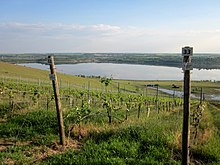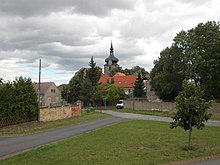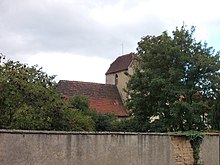Klobikau
|
Klobikau
City of Bad Lauchstädt
Coordinates: 51 ° 21 ′ 16 ″ N , 11 ° 50 ′ 37 ″ E
|
|
|---|---|
| Height : | 116 m |
| Area : | 11.98 km² |
| Residents : | 522 (March 31, 2015) |
| Population density : | 44 inhabitants / km² |
| Incorporation : | January 1, 2008 |
| Postal code : | 06246 |
| Area code : | 034635 |
|
Location of Klobikau in Bad Lauchstädt
|
|
Klobikau is a village and a district of the same name in the city of Bad Lauchstädt in the Saalekreis in Saxony-Anhalt .
geography
Geographical location
Klobikau is located between Halle (Saale) and Erfurt am Geiseltalsee . Lignite was mined in the south of the village for centuries . The thereby resulting heap Klobikau, a tailings pond with an area of about 300 hectares and a height of 218 meters is restored and recorded as a recreation area.
- The 14.5 m high observation tower Seeblick Klobikauer Höhe , built in 2002, is not far from an abandoned bunker on the Klobikau dump.
- The Goldener Steiger wine-growing area (with ostrich farm ) was laid out on around 30 hectares of the gently sloping bank areas in the north . The maintenance of the landscape is carried out by the Red Höhenvieh , a breed threatened with extinction.
- Above the vineyard is the "European meeting place for cultures".
Local division
The district is divided into the municipality parts:
- Niederklobikau
- Oberklobikau
Furthermore, the districts of Wünschendorf, Reinsdorf and Raschwitz were designated in 1950.
history
9th to 13th centuries
The place was mentioned for the first time as Cloboco in the Hersfeld tithe list that was created between 881 and 899 . The place name is of Slavic origin and is said to come from the word "hlubcky", which can be translated as "deep down, the black oak".
In the year 906 the place belonged to the inheritance of the Hatheburg von Merseburg , which fell to Heinrich I. after their wedding in that year . Immediately a dispute broke out between the church and the Liudolfingern over the entire inheritance of Hatheburg, because the latter had been widowed and a nun before the wedding with Heinrich I. On October 5, 908, Heinrich's father Otto the Illustrious , Duke of Saxony , decided not to pass on his position as lay abbot in the important imperial monastery of Hersfeld , whereupon the Hatheburg inheritance with "Cloboco" finally fell to the Liudolfinger. In 909, Heinrich I separated from Hatheburg, who again (this time as abbess, befitting her rank) went to a monastery. Otto the illustrious died in 912. In his place a cleric becomes abbot again (Diethard I.). On July 2, 936, Heinrich I died as king in the nearby Palatinate Memleben and bequeathed "Cloboco" to his son Otto I , who kept it until his death on May 7, 973 (also in the Palatinate Memleben ). Heir was his son Otto II.
On May 20, 979, Emperor Otto II in Allstedt and Abbot Gozbert von Hersfeld exchanged this place, the Muffendorf farm and the villages of Benkendorf, Salzmünde and Müllendorf including accessories for the tithe in Friesenfeld and Hessengau as well as in all associated castles and forts. He transferred this tithe to the Benedictine monastery of Memleben, which he had recently founded with his wife Theophanu in memory of his father Otto I. The Hersfeld Abbey was not placed directly under the Pope until 966 under Abbot Egilolf , Abbot Gozbert (from 970) founded a library there. In 985 (according to other sources 984) Abbot Gozbert died and Abbot Bernhar also succeeded Klobikau as the new master. On January 23 or 24, 1002 died with Otto III. the Saxon Ottonians in the male line, and on June 7, 1002, Heinrich II, a representative of the Bavarian branch line of the Ottonians, was elected King of East Franconia. This gave rise to entirely new priorities in politics at the time. On May 30, 1003, Heinrich II awarded the Hersfeld Abbey with the Reichsforst Eherinevirst a closed area around Hersfeld, which also established the territorial connection with its Thuringian possessions. With the Veste Wachsenburg (one of the " Three Equals "), the Hersfeld Abbey had already had protection for its Thuringian goods since around 930. Both Abbot Gozbert and Abbot Bernhar allowed the Benedictine rules to deteriorate and lived like canons in their own houses and with private assets - among other things at the expense of the Klobikauer at the time. Therefore, in 1005, Heinrich II. Godehard from the reform monastery Niederalteich appointed the new abbot in Hersfeld and thus Lords of Klobikau. Instead of following the Regula Benedicti , 50 monks preferred to leave the Hersfeld Abbey completely.
On November 1, 1007, an imperial synod began in Frankfurt am Main , at which Heinrich II established the diocese of Bamberg from parts of the dioceses of Würzburg and Eichstätt . This changed the church landscape in Germany considerably, with consequences for Klobikau and even Memleben. In 1012 Arnold , also from Niederalteich, became the new abbot of Hersfeld and the new master of Klobikau. Godehard later became Bishop of Hildesheim . On January 26, 1015, Emperor Heinrich II restituted the Hersfeld Monastery in Frankfurt "at the request and complaint of Abbot Arnold, the monks and the knighthood those lucrative rights to the tithe" (Regesta Imperii), which had to be assigned in favor of the Memleben Monastery, and took Klobikau and one more possession back. On February 5, 1015, he also exchanged Klobikau in Frankfurt, together with possessions in Wanfried and Liutfrideshusun, with Abbot Arnold von Hersfeld for the Rodheim, Welbhausen, Schnackenwerth and Wonfurt farms, which he transferred to the newly created diocese of Bamberg. On this occasion, Klobikau ("Cloboco") was referred to as lying in Hassegau ("Hassegowe").
Klobikau remained in the possession of the Hersfeld Abbey as it had been since 979 , to which the previously important Memleben monastery was now subordinated as a provost . Heinrich II was primarily concerned with giving his new foundation from 1007, the diocese of Bamberg, as rich as possible. The new economic power put Abbot Arnold von Hersfeld in a position to build a Benedictine provosty on the Johannesberg, whose former office building is still inhabited today (ruins are still evidence of the monastery church and the dormitory). The former collegiate church of Hersfeld as the largest Romanesque church ruin in Europe, at that time the "capital" of Klobikau, still bears witness to the former power and wealth of Hersfeld Abbey .
Between 1073 and 1074 King Heinrich IV gathered an army near Bebra-Breitenbach to put down an uprising by the Saxons and Thuringians. These disputes shook Hersfeld's position in Thuringia lastingly, which is why Abbot Friedrich (1091–1100) stayed mainly at the Wachsenburg (near Arnstadt), where he also died. In the meantime Count Hoyer von Mansfeld had acquired the county in Hassegau as a favorite of Heinrich IV. From the abandoned Wimmelburg he donated a monastery, which among other things is equipped with properties in Klobikau. The year of transition is not documented. In 1107 the Worms canon and provost Reinhard von Blankenburg was elected bishop in Halberstadt . This devoted himself to the monastery and foundation reforms, which enabled him to economically secure the monasteries and to strengthen the spiritual life. In 1121 he confirmed the Wimmelburg monastery near Eisleben in his possessions in Clobiche and various Hufen and other righteous people. In 1250 Meinhard von Kranichfeld , from 1241 to 1252 Bishop of Halberstadt, granted the Wimmelburg monastery further rights over the Klobikau church.
Around 1320 one finds the name "Klobeck" as the place name in the Merseburg register of goods (cf. Neue Mittheilungen from the field of historical-antiquarian research. In the name of the Thuringian = Saxon Association for the research of patriotic antiquity and associated with the Royal University of Halle-Wittenberg Preservation of his monuments, published by the secretary of the same Dr. K. Ed. Foerstemann. Second volume. Third and fourth booklet. Halle, in the Bureau of the Thuringian = Saxon Association, and Nordhausen, in Commission with Hermann Förstemann, 1836, Chapter XV., Goods = directory of the Merseburg bishopric from the XIVth century, communicated by Dr. K. Ed. Förstemann , p. 385).
14th century to the present
Today's five districts of the village of Klobikau belonged to the Merseburg bishopric , which had been under Electoral Saxon sovereignty since 1561 and belonged to the secondary school principality of Saxony-Merseburg between 1656/57 and 1738 . Wünschendorf, Ober- and Niederklobikau belonged as exclaves to the Merseburg office until 1815 , Reinsdorf and Raschwitz belonged to the Lauchstädt office . The decisions of the Congress of Vienna the places to Prussia came and were Merseburg in the administrative district of Merseburg of Saxony Province allocated to which they belonged to the 1952nd
On September 30, 1928, the Raschwitz manor district and the rural communities of Raschwitz, Reinsdorf and Wünschendorf were combined to form the municipality of Wünschendorf, which was incorporated into Niederklobikau on April 1, 1937. On July 1, 1950, the municipality of Klobikau emerged from the previously independent towns of Oberklobikau and Niederklobikau with Wünschendorf, Raschwitz and Reinsdorf.
Since January 1st, 2008, the formerly independent municipality of Klobikau has been part of the city of Bad Lauchstädt.
memorial
- Burial in the local cemetery for a particularly well-known Soviet woman during the Second World War deported to Germany and a victim of forced labor was
politics
Local Mayor
The honorary local mayor Christine Murre was already mayor of the municipality from May 6, 2001 until January 1, 2008 when it was incorporated.
Economy and Infrastructure
traffic
- The place is not far from the federal highway 38 , the exit Merseburg -Nord (24) is approx. 6 kilometers away.
Personalities
- August Ferdinand Richter (1822–1903), theologian and member of the Prussian House of Representatives
Individual evidence
- ↑ Klobikau lookout tower . In: Structurae (in other sources the height is given as 15 m or around 15 m).
- ^ Klobikau on the Bad Lauchstädt homepage
- ^ Karlheinz Blaschke , Uwe Ulrich Jäschke : Kursächsischer Ämteratlas , Leipzig 2009, ISBN 978-3-937386-14-0 , p. 84 f.
- ^ The district of Merseburg in the municipal directory 1900
- ↑ Wünschendorf on gov.genealogy.net
- ↑ Municipalities 1994 and their changes since January 1, 1948 in the new federal states , Metzler-Poeschel publishing house, Stuttgart, 1995, ISBN 3-8246-0321-7 , publisher: Federal Statistical Office
- ↑ StBA Area: changes from 01.01. until December 31, 2008
literature
- Steffan Bruns: Ortschronik Klobikau: including Nieder- and Oberklobikau, Wünschendorf, Reinsdorf (Saxony-Anhalt, Saalekreis, Black Valley), with the local family book of the communities. Complete evaluation of the church records for the years 1580–1879. Plaidt: Cardamina 2014, ISBN 978-3-86424-193-2
Web links
- Website of the city of Bad Lauchstädt
- Certificate of May 20, 979 RI II, 2 n.782, in: Regesta Imperii Online (accessed on January 28, 2015)
- Deed of January 26, 1015 RI II, 4 n.1857, in: Regesta Imperii Online (accessed on January 28, 2015)
- Document dated February 5, 1015 RI II, 4 n.1859, in: Regesta Imperii Online (accessed January 28, 2015)
- Entry in the Hochstift Merseburg register of goods around 1320 (p. 385) (accessed on January 28, 2015)






